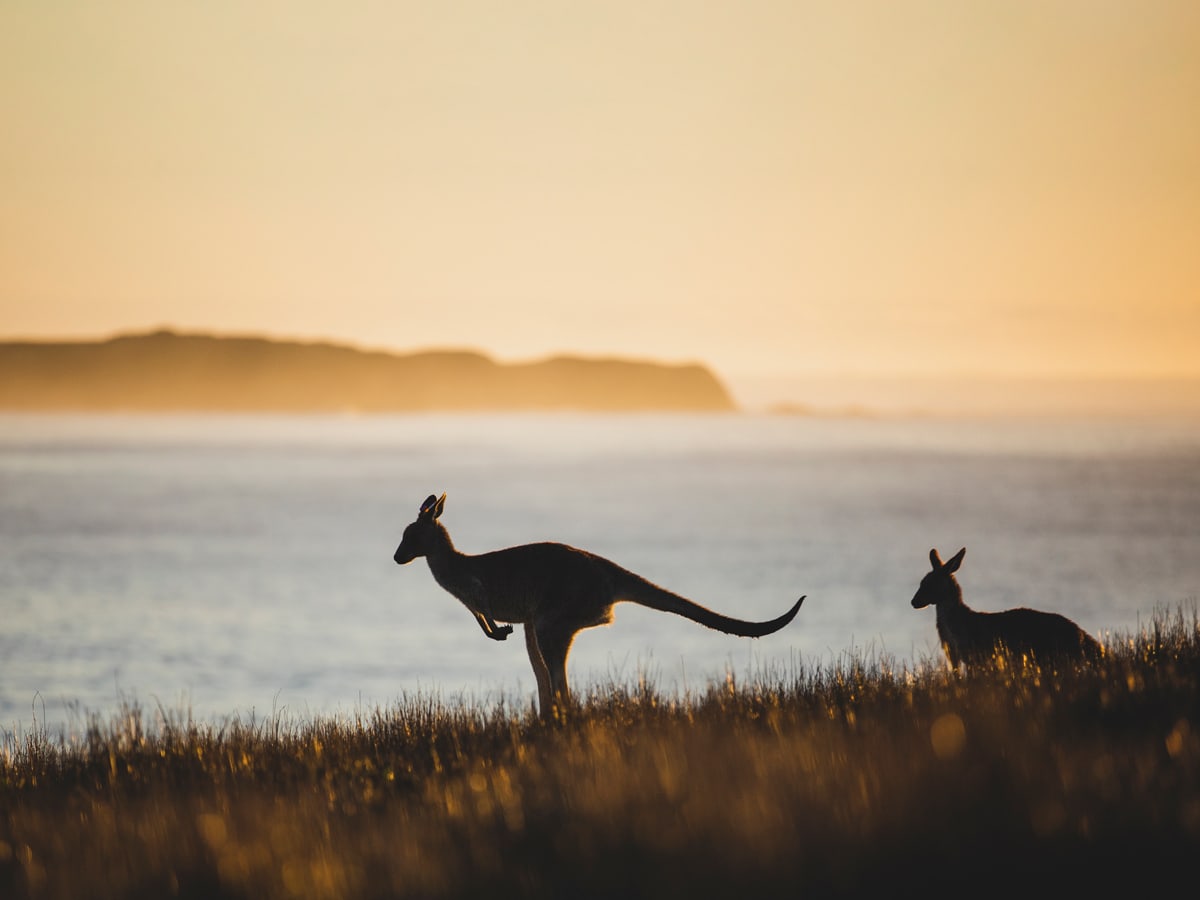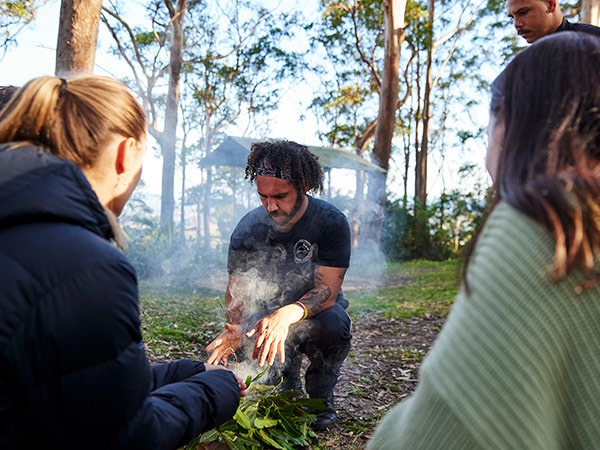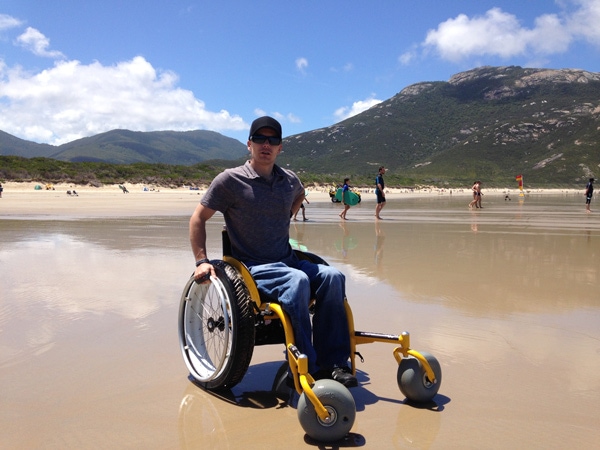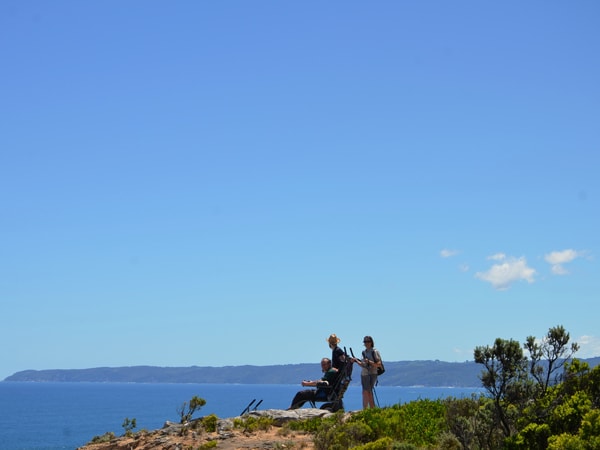06 June 2023
![]() 10 mins Read
10 mins Read

Journey with our writers as they take you into Australia’s top emerging sustainable experiences from our 100 Emerging Destinations and Experiences series.
Travelling with: Alexis Buxton-Collins
Clusters of juicy shiraz and tempranillo grapes poke out beneath extravagant garlands of leaves as I drive through the vineyard at Gemtree Wines to a restored wetland that has been planted with 50,000 trees and shrubs. For custodians Mike and Melissa Brown, this is a labour of love that began when they bought the South Australian property in 1998. For Ngarrindjeri Elder Mark Koolmatrie, the connection goes back far longer.

Make your way to a restored wetland at Gemtree Wines. (Image: South Australian Tourism Commission)
“This is Kaurna Country, but the same values exist as in Ngarrindjeri Land, which is just over that hill,” he tells our small group on the Wuldi Cultural Experience. “Our people have a concept called ngartji that means everyone has to look after something. It could be a wombat or an emu or a waterway, but if we all play our role, together we look after the planet.”
High above us, several sleepy rescue koalas are perched in the treetops. But Mark is just as excited about what’s going on at ground level. “These old logs don’t seem like much, but they create a habitat for beetles and bugs and lizards. And plants that look like weeds might provide food and shelter for a whole range of critters. Everything here plays its role.”

Sample the range of Gemtree Wines. (Image: South Australian Tourism Commission)
It’s a holistic approach that resonates with the biodynamic winemaking philosophy at Gemtree Wines, where soil, fruit, minerals and even the planets interact in a sublime cosmic dance. As the shadows grow longer, Mark leads us to a shed where glasses are filled with crisp fiano, juicy GSM and peppery shiraz.
We tuck into platters of food inspired by native ingredients such as crunchy macadamia and desert lime pesto wrapped in warrigal leaves. “Life can get pretty busy and it’s easy to forget what’s important,” Mark says as the conversation steadily grows louder. “But everything seems simpler when you can get back to nature in a place like this.”

Mark Koolmatrie to host Wuldi at the Gemtree Eco Trail. (Image: South Australian Tourism Commission)
Travelling with: Carla Grossetti
It takes just a few hours from Sydney to arrive in Berry, where I find a group of women aged between 20 and 60 arranged artistically on lounges waiting for the fun to begin. Excited chatter ricochets all around the space after Stand Tall Retreats’ founder Amy Manton outlines the three-day itinerary she has curated.

A yoga class is the perfect addition to your time at Stand Tall Retreat. (Image: Katie Rivers)
There’s a horse named Bill with my name on it. A surf lesson. My first reformer Pilates class. Some scheduled relaxation around the infinity pool looking out over green fields and brown cows. There’s hula hooping, a nutrition workshop and a relaxing reiki experience.
A vast sky full of stars also beckons each night after wholefood feasts shared around the communal table at Sinclairs of Berry. The Global Wellness Institute recently named Australia as the No. 1 wellness destination in the world. And Shoalhaven is shaping up as an emerging destination in that space.

Get cosy in this quaint abode. (Image: Katie Rivers)
This is thanks in part to its proximity smack bang between Sydney and Canberra and a roster of retreats designed to support meaningful connections between places and people. Being given those moments to sit and just be against a backdrop of beautiful beaches, unspoilt coastal villages and sun-lit escarpments provides us all with new ways of looking at the world and working out our place in it.
Sinclairs of Berry is one of several new retreats that revolve around wellness in the Shoalhaven. Tailor your retreat to suit by requesting everything from a weekend of Wim Hof-inspired ice baths to an Indigenous-led cultural experience, art therapy or a nature-focused retreat.

Soak up tropical vibes. (Image: Destination NSW)
Travelling with: Lara Picone
Gumbaynggirr Country as seen through the lens of Indigenous culture is a significant part of the Coffs Coast journey as NSW’s first ECO Destination. The region recently placed third at the prestigious 2023 Global Green Destinations Story Awards in the Culture and Tradition category thanks to the work being done by the trailblazing Bularri Muurlay Nyanggan Aboriginal Corporation. Indigenous Australians are the ultimate pioneers in conservation.

A wealth of Indigenous cultural experiences are on offer in Coffs. (Image: Destination NSW)
The Giingan Gumbaynggirr Cultural Experience is a celebration of Gumbaynggirr culture, people and language. It’s also a great example of ecologically sustainable tourism, as support of BMNAC helped fund the first bilingual language school in NSW.

Experience Coffs Coast nature in NSW’s first eco-destination. (Image: Destination NSW)
Travelling with: Taylah Darnell
If you’re looking for adventure, ditch the theme parks for a Gold Coast dive trail, which showcases 11 dive sites that remain hidden in plain sight. Check out Kirra Reef, protected on three sides by land for macro marine life or Southport’s Seaway, which has three unique spots flaunting everything from seahorses to sharks.

Dive underneath the Wonder Reef. (Image: Set in Stone Media)
The golden child of dive spots, however, is Wonder Reef off the coast of Main Beach, which was opened in June 2022. The $5 million site features nine enormous regenerative structures anchored to the ocean floor that sway in the current like kelp. Known as the world’s first buoyant reef, the site has eight, 18 and 30-metre descents for divers of all abilities.

Ditch the theme parks for a Gold Coast dive trail. (Image: Tourism and Events Queensland)
Travelling with: Elizabeth Whitehead
Bundaberg is best known as Australia’s rum capital. Surrounded by swathes of sugarcane, there’s plenty of things about Bundy, as it’s known among locals, that are totally sweet. For one, as of January this year, the Queensland region has been certified as an ECO Destination, meaning it offers up quality nature tourism experiences with a commitment to sustainability.

See sea turtles up close. (Image: Tourism and Events Queensland)
Just a 15-minute drive from town, Mon Repos Turtle Centre supports the largest concentration of nesting marine turtles on the eastern Australian mainland. And from next year, visitors will be able to stay at the Mon Repos Turtle Sands Nature Retreat, a new ecotourism experience that will immerse guests in the world of turtle conservation.

Stay close to the beach. (Image: Tourism and Events Queensland)
Travelling with: Fleur Bainger
The working lives of bees have inspired the design and function of six, boxy eco pods by the coast in WA’s Margaret River. Positioned only one kilometre from the salty spray of Smiths Beach, Barn Hives is the vision of Lithuanian beekeeper Egis Rusilas and his wife, Raminta – yet there’s nothing twee or Pooh Bear about them. Black and sleek, each one is raised up on stilts, just as commercial beehives are (to hinder critters).

Bask in tranquillity at this barn hive. (Image: Bianca Kate Photography)
The front deck overlooks vines, mimicking a bee’s preference for a clear flight path and a platform for landing. The minimalist luxe interiors are split into two levels, the top reserved for honey-making (it is the bedroom, after all) while the lower floor is the living area: this division is just the way hive bees have it.

Stumble upon a gaggle of geese. (Image: Bianca Kate Photography)
In addition, each pod leverages natural elements, with native jarrah wood cladding, solar power, rainwater and cooling, cross-ventilation airflow. Impressively, not a skerrick of plastic was used during the 2020 construction. Rusilas’ actual bees supply the pods with a jar of unprocessed, raw honey – also found in the property’s restaurant kitchen, Barnyard 1978.

Cool off at Smiths Beach.
Travelling with: Taylah Darnell
Journey 34 kilometres from Settlement Point in Port Macquarie to Crescent Head on Birpai and Dunghutti Country with Positive Energy Adventures and Retreats to clear your thoughts and move your body. Experience the benefits of hiking without added stress; replace a rucksack and swag with yoga, Pilates or meditation, hot breakfasts, glamping tents and sunset drinks.

Embark on a three-day coastal adventure. (Image: Alexandra Adoncello)
Like-minded locals Peta Alexopoulos and Belinda Johnson noticed a gap between wellbeing retreats and sustainability and launched their hikes in March to remedy this. The pair invite guests to connect with themselves as well as the land. You’ll wrap up this three-day adventure feeling healthier in mind, body and spirit knowing you haven’t left a heavy footprint, except for just a few in the sand.

Walk from Settlement Point in Port Macquarie to Crescent Head on Birpai and Dunghutti Country with Positive Energy Adventures and Retreats. (Image: Lindsay Moller Productions)
Travelling with: Elizabeth Whitehead
An estimated 1.3 billion people around the globe living with a disability, accessible tourism is a fast-growing area. Sydney was recently ranked by the Valuable 500 – a business collective striving for disability inclusion – as one of the top 10 most accessible cities in the world. While features such as public transport, wheelchair accessibility at attractions and the 2100-plus Braille street signs across the city were highly rated, there’s still plenty of room for improvement – in Sydney and beyond.

Sustainable travel must also cater to differently-abled people. (Image: Parks Victoria)
Luckily, technology is changing the face of travel by providing tools that allow people with disabilities to better navigate the world. One example is Vacayit, an app that uses compelling, high-quality audio stories to help blind and low-vision visitors connect to place with more than 120 guides around Australia. The app is compatible with assistive technology such as screen readers, transcripts and voice search to be more accommodating to users.
The tourism industry is also becoming more mindful of the diverse needs of visitors. The result is a more inclusive range of offerings, such as the beach wheelchairs available in Victoria’s coastal national parks, and thoughtful touches such as free sensory backpacks at WA Museum Boola Bardip in Perth to help accommodate children prone to overstimulation. Ultimately, inclusive travel recognises that we are all unique and that the joys of travel should be accessible to all.

See the beauty of the world from a different perspective. (Image: Parks Victoria)
Travelling with: Carla Grossetti
Queensland’s Fraser Coast is being billed as a Marine Mecca in a bid to highlight the wide range of magical experiences to be had around its pristine and protected waterways. The Fraser Coast has in recent years evolved into a prime spot for whale watching.

Go whale watching at Hervey Bay. (Image: Tourism and Events Queensland)
But the potential of this ancient meeting place puts everything from wreck and reef diving to bareboat sailing charters, fishing adventures, jet-ski tours, K’gari Adventures’ eco excursions and Indigenous cultural adventures in the limelight. The temperate subtropical climate also establishes this section of Australia’s East Coast as a year-round holiday destination.

Witness whales dance gracefully. (Image: Tourism and Events Queensland)
Thank You Once again for sharing such amazing places. You have a wonderful job going around and using that camera. It must be an honour to photo such wonderful places. And One has to admit. You certainly do a wonderful job. Once again Thank YOu for sharing. Regards Laurie Steward.